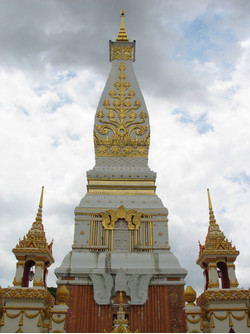Artwork Search
Arts in Southeast Asia Database
Phra That Phnom
Keywords : Bell-shaped Chedi, Phra That, Phra That Phnom
| Site common name | Phra That Phnom Woramahaviharn |
|---|---|
| Type of artwork | Architecture |
| Sub district | That Phanom |
| District | That Phanom |
| Province | Nakhon Phanom |
| Region | Northeast |
| Country | Thailand |
| Geographic Coordinates Decimal degree | Lat : 16.942662 Long : 104.723826 |
| Geographic Coordinates UTM | Zone : 47 Q Hemisphere : N E : 470594.19 N : 1873232.75 |
| Place of artwork | At the centre of the sacred zone |
| History of production | Although the Mythology of Uranghathat told a story of Phra That Phnom back to the age of Lord Buddha. However, the architectural style and other evidence point that this stupa might be built during the 9th to 10th century AD at the latest. Later, it was restored during the age of Kingdom of Lanchang during the 18th to 19th century AD and became a sacred stupa ever since. Some features which prove the dating to the 9th to 10th century AD are a brick anda in square plan, which is decorated by floral pattern, round pillars which are similar to Khmer Prei-Kmeng to Kampung-Preah Art. Therefore, scholars speculate its anda dating that should be around the 8th century AD. However, pilasters and decoration may be related to Cham architecture around the 9th to 10th century AD. However, the overall character displays the local style which is far different from the original character. The top part, which is a square-bell-shaped stupa, can be studied from the old photograph. It was plumper and shorter before it was made into higher and slimmer top during the government of Field Marchal P. Phibulsongkram. The top part was continuously restored in the age of Kingdom of Lanchang during the 18th to 19th century AD by, for instance, King Jayachedha or Praya Suriyawongadharmikraj and, especially, Monk Ponsamek as the manager of the restoration work in 1690 – 1691 AD, when the chamber inside an anda was closed permanently. During the government of Field Marchal P. Phibulsongkram in 1935 AD, the top part was made higher and slimmer, which was the main cause of the collapse in 1975 AD, which was later restored in 1979 AD. |
|---|---|
| Conservation | Phra That Phnom was listed and declared an ancient monument in the Government Gazette, no.52 section 75 on the 8th March 1935 During the government of Field Marchal P. Phibulsongkram in 1940 AD, a new top was built to cover the original square-bell shape. The weight and leaks in a stupa caused a severe collapse in 1975 AD. The major restoration after the collapse took time until 1979 AD, by following the form of the Field Marchal P. Phibulsongkram, but used ferroconcrete and foundation piles to ensure the stability. The carved elements were new assemble and some bricks were added. The Buddha relics which were found during the restoration were also put back into the original place. |
| Art | Phra That Phnom is a brick stupa in sqaure plan. The anda is not plastered, but decorated by virtual niches and round pilasters. Each corner is decorated by floral-pattern and figure of a man riding an animal. These features can be related to the Mythology of Uranghathat that Umong (Ubmung) was built by four kings. The upper chamber is beneath the square-bell-shaped top, which is the unique element of Lanchang Art. |
| Key academic information | Phra That Phnom is a sacred stupa of both Khong riversides and has been the heart of Buddhists for centuries. It had been replica built on other areas which shows the relationship between Thailand and Laos since the Kingdom of Lanchang period. |
| Period | Historical Period |
| Art period | Lanchang |
| Age | 17th century AD (except the chamber which might be built during the 9th to 10th century AD) |
| Religion | Buddhism |
| Religion and belief | Buddhism |
| Legend | The Mythology of Uranghathat, which was written in Lanchang period, told that when Lord Buddha came to Khong riversides, he prophesied that the area called Phu Kamprah, which was in the state of Sri Ghotrabura, would be the place where Uranghathat (relics from the chest bones) would be stored. After he attained to nirvana, Monk Mahakassapa brought Uranghathat to a stupa, which was built by five kings; Praya Suvarnabhinghara of Nonghan Luang, Praya Khamdaeng of Nonghan Noi, Praya Culanibrhamadat of Culani, Praya Indapatnagara of Intapatnagara and Praya Nandasen of Sri Ghotrabura. Those five kings would later be reincarnated as Arahans who, together with Praya Sumitradharmawongsa of Sri Ghotrabura and other kings, restored Phra Thatphnom again. For centuries that Phra Thatphnom was abandoned until the Kingdom of Lanchang, when there were many restoration works and left the historical evidence to be able to study. |
| Related artwork | Phra Thatphnom was reproduced upon other stupa, for example, Phra That Renu, Phra That Tha U-then, Phra That Wat Mahathat Nakhon Phnom and Phra that Krob Phra Phutthabat Buabok in Udorn Thani. |
| Type of License | Attribution-NonCommercial-NoDerivs (CC BY-NC-ND) |
|---|---|
| Rights | Princess Maha Chakri Sirindhorn Anthropology Centre |
| Date of record creation | 2015-09-21 |
| Record creator | Rungroj Thamrungraeng |
| Bibliography | เทพรัตนโมลี, พระ. ประวัติย่อพระธาตุพนม. พิมพ์ครั้งที่ 4, พระนคร : เฟื่องอักษร, 2514. ประภัสสร์ ชูวิเชียร. 5 มหาเจดีย์สยาม. กรุงเทพฯ : มิวเซียมเพรส, 2554. พระธาตุพนม. กรุงเทพฯ : เมืองโบราณ, 2518. ธรรมราชานุวัตร, พระ. และ โสภณเจติยาภิบาล, พระ. อุรังคนิทาน ตำนานพระธาตุพนม (พิสดาร). พิมพ์ครั้งที่ 11, กรุงเทพฯ : จูน พับลิชชิง, 2551. ศักดิ์ชัย สายสิงห์. เจดีย์ พระพุทธรูป ฮูปแต้ม สิม ศิลปะลาวและอีสาน. กรุงเทพฯ : มิวเซียมเพรส, 2555. สิริกุล จุมพล และคนอื่นๆ. แหล่งท่องเที่ยวอีสานบน. กรุงเทพฯ: กรมศิลปากร, 2534. อนุวิทย์ เจริญศุภกุล. พระธาตุพนม. กรุงเทพฯ : องค์การค้าของคุรุสภา, 2521. |


